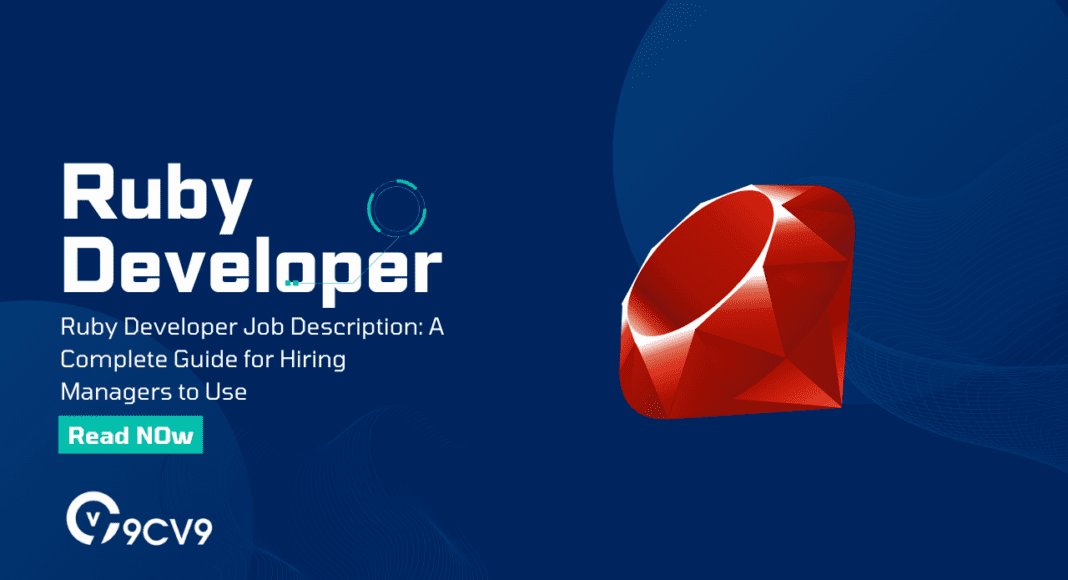Key Takeaways
- Discover the core responsibilities of a Ruby Developer and gain insights into building robust web applications.
- Explore the essential skillsets that set top Ruby Developers apart, from coding proficiency to problem-solving acumen.
- Ensure you’re equipped to hire the best Ruby talent with a deep understanding of the role’s key responsibilities and required skills.
In the ever-evolving landscape of technology, hiring the right talent for your organization is paramount to success.
When it comes to web development, Ruby is a programming language that has gained substantial popularity for its elegance, simplicity, and versatility.
However, finding the ideal Ruby developer for your team can be a challenging endeavor, especially when the competition for top-notch talent is fierce.
To navigate this complex hiring process, you need a powerful tool in your arsenal: a well-crafted and comprehensive Ruby Developer Job Description.
This guide aims to be your ultimate resource, equipping hiring managers like you with the knowledge and insights necessary to attract, evaluate, and ultimately hire the best Ruby developers in the industry.
In the pages that follow, we will delve deep into the nuances of the Ruby developer role, dissecting the essential skills, qualifications, and attributes that make a candidate stand out.
Whether you’re a seasoned HR professional or a startup founder looking to expand your tech team, this guide will serve as your roadmap to crafting a job description that not only captures the essence of the role but also magnetizes top-tier Ruby talent to your doorstep.
Our journey will take us through the fundamental components of an effective job description, offering practical tips and examples along the way.
We will explore the technical skills that distinguish a proficient Ruby developer from the rest, but we won’t stop there.
Soft skills and cultural fit are equally vital in building a cohesive and productive team, and we’ll show you how to highlight these aspects in your job posting.
Furthermore, we’ll discuss the critical role that Ruby plays in modern web development and why it’s an attractive choice for developers.
Understanding the language’s strengths and applications will empower you to articulate your company’s vision and the exciting projects that await your new Ruby developer.
Additionally, we’ll share insights into industry trends and best practices, ensuring that your job description remains current and appealing to candidates in an ever-evolving tech world.
After all, attracting top Ruby talent isn’t just about listing qualifications; it’s about painting a compelling picture of the opportunities and challenges that lie ahead.
Whether you’re a HR professional, a tech startup founder, or an established corporation seeking to bolster your development team, this guide will be your compass in the world of Ruby developer recruitment.
So, let’s embark on this journey together and unlock the secrets to creating a Ruby Developer Job Description that sets your organization apart, attracts top talent, and propels your projects to new heights.
Before we venture further into this article, we like to share who we are and what we do.
About 9cv9
9cv9 is a business tech startup based in Singapore and Asia, with a strong presence all over the world.
With over six years of startup and business experience, and being highly involved in connecting with thousands of companies and startups, the 9cv9 team has listed some important learning points in this overview of the guide to creating the best Ruby Developer Job Description.
If your company needs recruitment and headhunting services to hire top-quality Ruby Developer employees, you can use 9cv9 headhunting and recruitment services to hire top talents and candidates. Find out more here, or send over an email to [email protected].
Or just post 1 free job posting here at 9cv9 Hiring Portal in under 10 minutes.
Ruby Developer Job Description: A Complete Guide for Hiring Managers to Use
- What is a Ruby Developer?
- Sample Job Briefs/Job Overviews for a Ruby Developer
- Key Responsibilities of a Ruby Developer in a Job Description
- Required Skills and Qualifications in a Ruby Developer Job Description
1. What is a Ruby Developer?
In the ever-expanding universe of programming languages, Ruby stands out as a gem (no pun intended).
And those who harness its power to craft robust and dynamic web applications are known as Ruby Developers.
Unveiling Ruby: A Language of Elegance
Ruby, often celebrated for its elegance and simplicity, was created by Yukihiro “Matz” Matsumoto in the mid-1990s.
Matz designed Ruby with a focus on developer happiness, emphasizing readability and productivity. This commitment to programmer-friendliness has made Ruby a beloved choice among developers worldwide.
The Role of a Ruby Developer
Ruby Developers are the architects and builders of web applications, utilizing the Ruby programming language, and often, the Ruby on Rails framework, to create dynamic and interactive websites and web-based systems.
They are the artisans who bring life to web applications, handling everything from backend logic to user interface design.
Key Responsibilities of a Ruby Developer
1. Coding and Development: At the core of their role, Ruby Developers write clean, efficient, and maintainable code. They craft the logic that powers web applications, ensuring they function smoothly and efficiently.
2. Web Application Architecture: Ruby Developers design the architecture of web applications, determining how different components interact and ensuring scalability, security, and performance.
3. Database Management: They work with databases, storing and retrieving data efficiently, often using technologies like PostgreSQL or MySQL.
4. Web Frameworks: Many Ruby Developers are well-versed in Ruby on Rails, a popular web framework, which streamlines development and provides a structured approach to building web applications.
5. Testing and Debugging: They rigorously test and debug code to identify and fix issues, ensuring a seamless user experience.
6. Collaboration: Ruby Developers often collaborate closely with frontend developers, designers, and project managers to bring the vision of a web application to life.
7. Continuous Learning: Given the dynamic nature of technology, Ruby Developers stay up-to-date with the latest trends, tools, and best practices in web development.
Why Choose Ruby?
So, why do developers and organizations choose Ruby? It’s because Ruby offers a myriad of benefits:
1. Readability and Productivity: Ruby’s clean and readable syntax enhances developer productivity, making it easier to write and maintain code.
2. Community and Libraries: Ruby boasts a vibrant and supportive developer community, along with a treasure trove of open-source libraries and gems that accelerate development.
3. Rails Framework: Ruby on Rails, often referred to simply as Rails, is a powerful framework that follows the “Convention over Configuration” principle, reducing the need for developers to make repetitive decisions and speeding up development.
4. Scalability: Ruby applications can be scaled to handle increased traffic and data, making it suitable for both startups and large enterprises.
5. Flexibility: Ruby’s dynamic nature allows developers to adapt to changing project requirements with ease.
In a world driven by digital innovation, Ruby Developers are the maestros who craft the web applications that power our daily lives.
Their expertise in Ruby and related technologies enables them to create web experiences that are not only functional but also delightful to use.
Whether you’re an aspiring Ruby Developer looking to embark on this exciting journey or an organization seeking to harness the power of Ruby for your web projects, understanding the role and capabilities of Ruby Developers is the first step towards success in the dynamic realm of web development.
Stay tuned as we delve deeper into the world of Ruby development, exploring the skills, qualifications, and tools that make a Ruby Developer truly exceptional.
2. Sample Job Briefs/Job Overviews for a Ruby Developer
Are you a seasoned Ruby Developer with a passion for crafting scalable and high-performance web applications? We are seeking a Senior Ruby Developer to join our dynamic team. In this role, you will take the lead in architecting, designing, and implementing robust Ruby-based solutions. Your expertise will be pivotal in shaping the future of our web development projects and ensuring their success.
Are you an aspiring Ruby Developer eager to kickstart your career in web development? We’re seeking a Junior Ruby Developer who is passionate about coding and eager to learn. In this role, you’ll have the opportunity to work closely with experienced developers, gaining hands-on experience in Ruby and Ruby on Rails development.
We are looking for a skilled Ruby Developer to join our team. As a Ruby Developer, you will be responsible for developing and maintaining web applications using Ruby and Ruby on Rails. You will collaborate with cross-functional teams to deliver high-quality software solutions.
We are seeking a Senior Ruby Developer to lead the development of our Ruby-based web applications. In this role, you will leverage your expertise in Ruby and Ruby on Rails to architect and build scalable and efficient solutions that drive our projects forward.
If you’re a passionate beginner with a knack for coding, we invite you to join our team as a Junior Ruby Developer. In this role, you’ll have the opportunity to learn from experienced developers and gain hands-on experience in Ruby web development.
Are you a student or recent graduate looking to kickstart your career in web development? We’re offering an internship opportunity for a Ruby Developer. As an intern, you’ll work alongside our development team, gaining valuable experience in Ruby and web application development.
We are in search of a Lead Ruby Developer to take charge of our Ruby projects. As a Lead Developer, you’ll be responsible for guiding the technical direction of our Ruby-based applications, mentoring the team, and ensuring the successful execution of development initiatives.
3. Key Responsibilities of a Ruby Developer in a Job Description
In this section, we present a comprehensive list of key responsibilities that will help you create an enticing and informative job description for your Ruby Developer position.
Below are some sample sentences and job scopes that you can use in your Ruby Developer job description to hire the best Ruby Developers.
Key Responsibilities of a Ruby Developer in a Job Description:
- Collaborate with cross-functional teams to define project requirements and objectives.
- Design and develop Ruby-based web applications, ensuring their scalability, security, and performance.
- Write clean, maintainable, and efficient Ruby code, adhering to coding standards and best practices.
- Work with databases to store and retrieve data efficiently, optimizing queries as needed.
- Perform thorough testing and debugging to identify and resolve issues promptly.
- Implement responsive and user-friendly web interfaces using HTML, CSS, and JavaScript.
- Utilize the Ruby on Rails framework to streamline development processes and maintain codebase consistency.
- Build and maintain APIs to facilitate data exchange between web applications and external systems.
- Collaborate with frontend developers to integrate frontend components seamlessly with the backend.
- Employ version control systems (e.g., Git) to manage codebase and collaborate with team members.
- Follow agile development methodologies and participate in sprint planning, stand-ups, and retrospectives.
- Stay up-to-date with the latest trends and technologies in Ruby and web development.
- Optimize application performance, troubleshoot bottlenecks, and implement performance improvements.
- Ensure the security of web applications by implementing proper authentication and authorization mechanisms.
- Participate in code reviews to maintain code quality and adherence to coding standards.
- Document code and technical processes for reference and knowledge sharing within the team.
- Collaborate with project managers to estimate project timelines and deliver software on schedule.
- Maintain and update existing Ruby applications, addressing bugs and implementing feature enhancements.
- Provide technical support and guidance to junior developers, fostering a collaborative team environment.
- Research and evaluate third-party libraries and tools to enhance development capabilities.
- Contribute to the continuous improvement of development processes and workflows.
- Troubleshoot and resolve production issues, providing quick and effective solutions.
- Participate in discussions about architecture and system design to make informed technical decisions.
- Proactively identify areas for code optimization and refactor code when necessary.
- Implement and maintain automated testing frameworks to ensure software reliability.
- Collaborate with DevOps teams to deploy and manage applications in production environments.
- Engage in knowledge sharing and mentoring to foster a culture of learning and growth within the organization.
- Conduct code reviews and provide constructive feedback to peers to ensure code quality and consistency.
- Implement authentication and authorization mechanisms, ensuring secure user access to web applications.
- Develop and maintain background processing tasks using tools like Sidekiq or Resque.
- Optimize database queries and schema design to enhance application performance.
- Implement and maintain caching strategies to reduce load times and server overhead.
- Collaborate with UX/UI designers to ensure seamless integration of design elements.
- Troubleshoot and resolve scalability issues as web traffic and data volume grow.
- Maintain awareness of web security best practices and proactively address potential vulnerabilities.
- Collaborate with DevOps teams to automate deployment and infrastructure management using tools like Docker and Kubernetes.
- Monitor application logs and performance metrics to identify and address issues in real-time.
- Implement responsive design principles to ensure web applications function smoothly across various devices and screen sizes.
- Collaborate with product managers to gather and refine requirements, ensuring alignment with business objectives.
- Keep documentation up-to-date, including API documentation and technical guides for team members.
- Create and maintain unit tests and integration tests to verify the correctness of code changes.
- Participate in on-call rotations to provide 24/7 support for critical production issues.
- Stay informed about Ruby and Ruby on Rails updates, patches, and security vulnerabilities, applying updates as needed.
- Collaborate with quality assurance (QA) teams to ensure thorough testing and validation of software features.
- Engage in performance tuning and code profiling to identify and resolve bottlenecks.
- Implement continuous integration and continuous deployment (CI/CD) pipelines to automate testing and deployment processes.
- Research and experiment with emerging technologies and libraries to enhance development capabilities.
- Collaborate with frontend developers to ensure the seamless integration of frontend and backend components.
- Maintain codebase version history and documentation using tools like Git and Wiki systems.
- Participate in codebase refactoring efforts to improve code maintainability and readability.
- Contribute to the development of coding standards and best practices within the organization.
- Stay up-to-date with industry trends and best practices in web development and share insights with the team.
- Assist in evaluating and selecting third-party tools and services that enhance development efficiency and functionality.
- Participate in post-launch activities such as monitoring, bug tracking, and performance optimization.
- Collaborate with stakeholders to define technical requirements and provide input on project feasibility and scope.
- Continuously seek opportunities to enhance the user experience and functionality of web applications.
- Collaborate with data engineers and data scientists to integrate data analytics and visualization features into web applications.
- Implement and maintain web security measures such as SSL/TLS encryption, data validation, and input sanitation.
- Develop and maintain RESTful APIs for seamless integration with third-party services and applications.
- Troubleshoot and resolve compatibility issues across different web browsers and platforms.
- Implement automated testing frameworks like RSpec for behavior-driven development (BDD) and testing.
- Optimize code for memory usage and resource efficiency to ensure applications perform well under load.
- Collaborate with customer support teams to investigate and resolve user-reported issues.
- Participate in code refactoring and restructuring efforts to improve code maintainability and readability.
- Create and maintain comprehensive technical documentation for applications, APIs, and system architecture.
- Assist in database schema design and optimization for efficient data storage and retrieval.
- Ensure compliance with data protection and privacy regulations, such as GDPR and HIPAA, when handling user data.
- Integrate analytics tools and services to track user behavior and gather insights for application improvements.
- Implement continuous monitoring and logging solutions to proactively identify and address issues in production.
- Collaborate with frontend teams to implement responsive and pixel-perfect designs.
- Provide technical guidance during the requirements gathering and scoping phases of projects.
- Collaborate with project managers to estimate development timelines and resource requirements.
- Participate in knowledge-sharing sessions and mentor junior developers to facilitate skill development.
- Stay informed about emerging trends and best practices in Ruby development and web technologies.
- Create and maintain development environments using tools like Docker and Vagrant for consistent development workflows.
- Ensure codebase adherence to coding standards and best practices through code reviews and automated checks.
- Assist in the planning and execution of load testing and performance testing to assess application scalability.
- Collaborate with marketing and SEO teams to implement on-page SEO optimizations.
- Contribute to the creation of development roadmaps and technology strategies for the organization.
- Participate in technology stack evaluations and make recommendations for stack improvements.
- Collaborate with frontend teams to implement client-side scripting for dynamic web features.
- Assist in the implementation of user authentication and authorization mechanisms, including OAuth and Single Sign-On (SSO).
- Provide technical support and guidance during the deployment of applications and updates.
- Stay current with Ruby and Ruby on Rails community developments and contribute to open-source projects when possible.
- Collaborate with cross-functional teams to ensure the successful delivery of projects within scope and timeline constraints.
Please note that the bullet points provided can be tailored and expanded to align with the specific requirements and preferences of the hiring company.
Also, do have a read at our most popular guide: Mastering the Art of Writing Effective Job Descriptions: A Comprehensive Guide
4. Required Skills and Qualifications in a Ruby Developer Job Description
When it comes to finding the perfect Ruby Developer for your organization, identifying the essential skills and qualifications is crucial.
In this section, we present an extensive list of skills and qualifications that will help you create an informative and enticing job description for the position.
Required Skills and Qualifications in a Ruby Developer Job Description:
- Proficiency in the Ruby programming language, including knowledge of its syntax, libraries, and best practices.
- Strong expertise in Ruby on Rails, with the ability to develop robust web applications using the framework.
- Experience with frontend technologies such as HTML, CSS, and JavaScript to collaborate effectively with frontend developers.
- Competence in working with databases, including designing schemas, writing SQL queries, and using database management systems (e.g., PostgreSQL, MySQL).
- Knowledge of web security best practices, including secure coding, data validation, and protection against common web vulnerabilities (e.g., SQL injection, XSS).
- Experience with version control systems like Git to manage codebase history and facilitate collaboration.
- Familiarity with agile development methodologies, including Scrum or Kanban, for efficient project management.
- Proficient in using web development tools and debugging techniques to identify and resolve issues efficiently.
- Ability to implement responsive and mobile-first design principles for cross-device compatibility.
- Strong problem-solving skills and a detail-oriented approach to writing clean and maintainable code.
- Knowledge of web performance optimization techniques, including caching, lazy loading, and resource minification.
- Experience in implementing and consuming RESTful APIs for data exchange with external services and applications.
- Competence in writing and maintaining unit tests and integration tests using testing frameworks like RSpec.
- Understanding of continuous integration and continuous deployment (CI/CD) pipelines for automated testing and deployment.
- Familiarity with containerization technologies such as Docker for consistent development and deployment environments.
- Excellent communication and teamwork skills for effective collaboration with cross-functional teams.
- Proficiency in documenting code, technical processes, and system architecture for reference and knowledge sharing.
- Strong analytical and troubleshooting abilities to diagnose and address complex technical issues.
- Knowledge of performance tuning and profiling tools to optimize application performance.
- Awareness of web accessibility standards (e.g., WCAG) and the ability to implement accessible web features.
- Experience with building and maintaining background processing tasks using tools like Sidekiq or Resque.
- Understanding of scalability principles and the ability to address scalability challenges as web traffic grows.
- Familiarity with data analytics and visualization tools to integrate data-driven features into web applications.
- Knowledge of secure authentication and authorization mechanisms, including OAuth and Single Sign-On (SSO).
- Awareness of data protection and privacy regulations (e.g., GDPR, HIPAA) when handling user data.
- Proven ability to keep up-to-date with industry trends and best practices in Ruby development and web technologies.
- Strong commitment to code quality and adherence to coding standards and best practices.
- Capability to mentor junior developers and provide technical guidance to team members.
- Experience with implementing on-page SEO optimizations in collaboration with marketing and SEO teams.
- Knowledge of container orchestration platforms like Kubernetes for managing containerized applications.
- A bachelor’s degree in computer science, software engineering, or a related field (or equivalent work experience).
- Proven work experience as a Ruby Developer, typically ranging from junior to senior levels based on the role.
- A portfolio of past projects and code samples demonstrating expertise in Ruby and Ruby on Rails development.
- Relevant certifications or training in Ruby and web development may be advantageous.
- Ongoing commitment to professional development and staying current with industry advancements.
- Strong knowledge of Object-Oriented Programming (OOP) principles and design patterns, with the ability to apply them effectively in Ruby development.
- Proficiency in using RubyGems and the ability to leverage third-party libraries and gems to enhance development efficiency.
- Experience with frontend frameworks and libraries such as React, Angular, or Vue.js for full-stack development.
- Competence in using NoSQL databases (e.g., MongoDB, Redis) for specific project requirements.
- Familiarity with GraphQL for efficient and flexible data querying in web applications.
- Ability to implement and maintain WebSocket connections for real-time features and notifications.
- Proficient in optimizing database queries using query optimization techniques and indexing.
- Knowledge of internationalization (i18n) and localization (l10n) for building multilingual web applications.
- Experience with asynchronous programming and background job processing for handling time-consuming tasks.
- Understanding of microservices architecture and the ability to develop and maintain microservices in Ruby.
- Knowledge of containerization and orchestration platforms (e.g., Docker Swarm, Amazon ECS) for deploying containerized applications.
- Familiarity with serverless computing platforms (e.g., AWS Lambda, Google Cloud Functions) for event-driven architectures.
- Proficiency in using continuous integration and continuous deployment (CI/CD) tools such as Jenkins, Travis CI, or CircleCI.
- Experience with performance monitoring and profiling tools (e.g., New Relic, AppDynamics) to optimize application performance.
- Knowledge of browser developer tools for debugging frontend code and diagnosing rendering issues.
- Proficient in using frontend build tools and package managers (e.g., Webpack, npm, Yarn) for optimizing asset delivery.
- Familiarity with cloud computing platforms (e.g., AWS, Azure, Google Cloud) and their services for web application deployment.
- Competence in optimizing web applications for search engine optimization (SEO) and familiarity with SEO best practices.
- Experience with version control workflows such as Git branching strategies (e.g., GitFlow).
- Knowledge of software architecture principles, including modularization, separation of concerns, and code modularity.
- Proficiency in writing and maintaining automated tests for different layers of the application stack.
- Understanding of web security concepts, including secure coding practices, authentication, and authorization mechanisms.
- Ability to create and manage infrastructure as code (IaC) using tools like Terraform or AWS CloudFormation.
- Knowledge of data migration and data transformation processes for database schema changes.
- Experience with continuous monitoring and logging solutions (e.g., ELK Stack) for proactive issue detection and resolution.
- Proficiency in working with cross-functional teams and stakeholders to gather and refine technical requirements.
- Strong organizational and time management skills to prioritize and manage multiple tasks and projects effectively.
- Ability to adapt to evolving technologies and programming languages, expanding skills beyond Ruby when necessary.
- A master’s degree or advanced certifications in computer science, software engineering, or related fields may be preferred for senior-level positions.
- Proven experience in building and maintaining complex, high-traffic web applications, with a demonstrated track record of successful project delivery.
- Participation in open-source Ruby projects or contributions to the Ruby community.
- Professional certifications in Ruby, Ruby on Rails, or related technologies (e.g., Ruby Association Certified Ruby Programmer).
- Familiarity with compliance standards and regulations relevant to the industry or sector of the hiring organization (e.g., PCI DSS, healthcare compliance).
- Demonstrated leadership experience in a technical capacity, such as leading development teams or projects.
- Experience with mentoring and training junior developers and fostering a culture of continuous learning.
- Participation in hackathons, coding competitions, or developer communities to showcase technical skills and creativity.
- Membership in relevant professional organizations (e.g., Ruby community groups, developer associations).
- Ability to implement and maintain serverless applications using frameworks like AWS Lambda, Azure Functions, or Google Cloud Functions.
- Proficiency in using Ruby testing tools such as Capybara and Factory Bot for comprehensive testing.
- Experience with message queuing systems like RabbitMQ or Apache Kafka for managing asynchronous tasks and communication between microservices.
- Knowledge of container orchestration platforms such as Kubernetes or Docker Swarm for managing containerized applications at scale.
- Familiarity with GraphQL schema design and implementation for efficient data querying and strong typing.
- Proficiency in creating and managing infrastructure in a cloud environment using infrastructure as code (IaC) tools like Terraform.
- Experience with integrating artificial intelligence (AI) and machine learning (ML) components into web applications using Ruby.
- Competence in implementing and securing GraphQL APIs to expose data for frontend consumption.
- Knowledge of search engines and indexing technologies like Elasticsearch or Apache Solr for implementing robust search functionality.
- Proficiency in setting up and configuring web servers and application servers such as Nginx, Apache, and Unicorn.
- Understanding of Single Page Application (SPA) frameworks like React, Angular, or Vue.js for building interactive frontend components.
- Experience with containerization and deployment of Ruby applications using Docker and Kubernetes in a cloud environment.
- Knowledge of identity and access management (IAM) principles and security best practices in cloud platforms.
- Proficiency in writing custom Ruby gems for reusable code components and libraries.
- Experience with web analytics tools like Google Analytics or Mixpanel for tracking user behavior and making data-driven decisions.
- Competence in integrating and securing payment gateways and e-commerce functionalities in web applications.
- Knowledge of authentication mechanisms such as OAuth 2.0 and OpenID Connect for enabling secure user access.
- Proficiency in implementing continuous monitoring and automated alerting systems for application health and performance.
- Experience with content management systems (CMS) and headless CMS solutions for flexible content management in web applications.
- Competence in managing and optimizing the use of content delivery networks (CDNs) for asset delivery and global scalability.
- Knowledge of progressive web app (PWA) development principles for enhanced user experiences on mobile devices.
- Proficiency in using code analysis and code quality tools (e.g., RuboCop, CodeClimate) to maintain codebase integrity.
- Experience with web security scanning and penetration testing tools (e.g., OWASP ZAP) for vulnerability assessment.
- Competence in troubleshooting and optimizing application deployments in cloud-based serverless environments.
- Knowledge of event-driven architecture patterns and experience with implementing event sourcing and event-driven microservices.
- Proficiency in setting up and configuring CI/CD pipelines using tools like Jenkins, GitLab CI/CD, or Travis CI.
- Experience with data warehousing solutions (e.g., Amazon Redshift, Google BigQuery) for analytics and reporting purposes.
- Competence in optimizing web application performance through techniques like image optimization and lazy loading.
- Knowledge of serverless databases and managed database services in cloud platforms (e.g., AWS Aurora, Azure Cosmos DB).
- Proficiency in optimizing web applications for voice search and voice assistant integration.
- Experience with mobile app development using Ruby-based frameworks such as RubyMotion or Ruby for iOS/Android.
- Competence in working with cross-functional teams across different time zones and locations to facilitate global collaboration.
- Advanced degrees (e.g., Master’s or Ph.D.) in computer science, software engineering, or related fields for senior and leadership positions.
- Recognized industry certifications in Ruby, Ruby on Rails, cloud platforms, or related technologies (e.g., AWS Certified Developer, Google Cloud Professional Developer).
- Significant open-source contributions to the Ruby community or other relevant open-source projects.
- Leadership roles in industry-related organizations or associations.
- In-depth experience with regulatory compliance and certification processes related to specific industries or sectors.
- Proven track record of leading large-scale development projects or teams.
- Recognition as a thought leader in Ruby development through speaking engagements, publications, or industry awards.
- Participation in hackathons, coding competitions, or developer communities as a judge or mentor.
- Active involvement in diversity and inclusion initiatives within the tech community.
Remember to customize and prioritize the skills and qualifications based on your specific requirements and the needs of your organization.
Highlight the skills and qualifications that are most relevant to your Ruby Developer position, and craft a compelling job description that attracts top talent in the field.
To kickstart hiring a top-quality Ruby Developer, post 1 free job posting at 9cv9 Job Portal.
Conclusion
In the dynamic world of web development, the demand for skilled Ruby Developers continues to surge.
As technology advances and businesses strive to provide cutting-edge digital experiences, having the right talent on board is paramount.
This comprehensive guide has delved deep into the nuances of crafting the perfect Ruby Developer job description, equipping hiring managers with the tools they need to identify and attract top-tier talent.
From defining the role and its significance to exploring the key responsibilities and required skills, we’ve navigated through the essential elements of a Ruby Developer’s job description.
We’ve uncovered the fundamental qualifications and competencies that make a Ruby Developer not just an asset but a driving force behind innovative web applications.
As you prepare to embark on your quest for the ideal Ruby Developer, remember that your job description is more than just a document; it’s your first point of contact with potential candidates.
It sets the tone for your company’s culture, values, and vision.
By crafting a compelling and detailed job description, you not only cast a wide net to attract top talent but also communicate your commitment to excellence and innovation.
The role of a Ruby Developer extends far beyond coding prowess.
It requires adaptability, problem-solving skills, and a continuous thirst for knowledge in a fast-evolving landscape.
Ruby Developers are the architects of web applications, the guardians of user experiences, and the pioneers of technological advancement. They bring life to ideas, turning concepts into functional, user-friendly web solutions.
In conclusion, when you’re drafting your Ruby Developer job description, think beyond the technical skills and qualifications.
Consider the passion, innovation, and drive that you seek in your next team member.
The ideal Ruby Developer is not just a coder but a creator, a collaborator, and a problem-solver.
This complete guide empowers you to cast a wide net, attracting a diverse pool of talent, and finding the perfect fit for your organization’s unique needs.
By adhering to the insights and tips shared here, you’ll be well on your way to assembling a team of Ruby Developers who will shape the future of your web development projects and drive your organization’s success.
Remember, hiring is a two-way street.
Just as you seek the perfect candidate, they too are searching for the ideal workplace.
Use your job description not only to outline expectations but to paint a vivid picture of your company’s culture, values, and the exciting challenges that lie ahead.
By doing so, you’ll be well-positioned to not only attract the best Ruby Developers but to build a dynamic and forward-thinking team that will lead your organization to new heights in the digital realm.
Happy hiring.
If your company needs HR, hiring, or corporate services, you can use 9cv9 hiring and recruitment services. Book a consultation slot here, or send over an email to [email protected].
If you find this article useful, why not share it with your hiring manager and C-level suite friends and also leave a nice comment below?
We, at the 9cv9 Research Team, strive to bring the latest and most meaningful data, guides, and statistics to your doorstep.
To get access to top-quality guides, click over to 9cv9 Blog.
People Also Ask
How to hire a Ruby Developer?
To hire a Ruby Developer, define job requirements, craft a compelling job description, assess coding skills, review past projects, and gauge problem-solving abilities. Look for a cultural fit, and consider remote or in-house options to find the right talent for your web development needs.
What is the Ruby Developer salary?
The Ruby Developer salary varies by location and experience. In the United States, it can range from $60,000 to $150,000 per year. Factors include skill level, location, and the specific industry or company.
Where to find some top great Ruby Developer?
To find top Ruby Developers, explore platforms like 9cv9, Stack Overflow, and Ruby-specific job boards. Attend Ruby conferences and network with Ruby communities. Consider recruiting agencies and leverage your company’s social media and website to attract top talent.































![Writing A Good CV [6 Tips To Improve Your CV] 6 Tips To Improve Your CV](https://blog.9cv9.com/wp-content/uploads/2020/06/2020-06-02-2-100x70.png)


